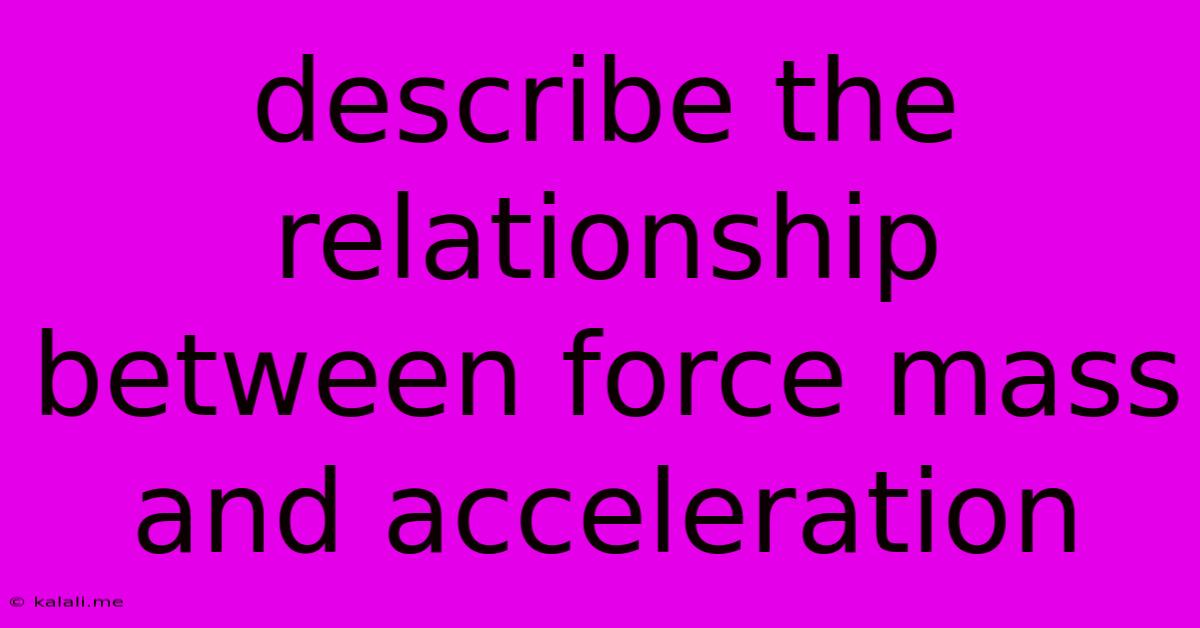Describe The Relationship Between Force Mass And Acceleration
Kalali
Jun 15, 2025 · 3 min read

Table of Contents
Understanding the Relationship Between Force, Mass, and Acceleration: Newton's Second Law of Motion
This article explores the fundamental relationship between force, mass, and acceleration, a cornerstone of classical mechanics described by Newton's Second Law of Motion. Understanding this relationship is crucial for comprehending how objects move and interact within the physical world. We'll delve into the equation, explore real-world examples, and address common misconceptions.
Newton's Second Law of Motion, often expressed as F = ma, states that the acceleration of an object is directly proportional to the net force acting on it and inversely proportional to its mass. This means that a larger force will result in a greater acceleration, while a larger mass will result in a smaller acceleration for the same applied force.
Breaking Down the Equation: F = ma
-
F (Force): This represents the net force acting on an object. Force is a vector quantity, meaning it has both magnitude (size) and direction. The net force is the sum of all forces acting on the object, considering their directions. Units are typically Newtons (N).
-
m (Mass): This represents the object's mass, a measure of its inertia – its resistance to changes in motion. A larger mass means greater inertia, requiring a larger force to achieve the same acceleration. Units are typically kilograms (kg).
-
a (Acceleration): This represents the rate at which the object's velocity changes over time. Acceleration is also a vector quantity, with both magnitude and direction. Units are typically meters per second squared (m/s²).
Understanding the Proportional Relationships
The equation highlights two key proportional relationships:
-
Direct proportionality between Force and Acceleration: If you double the net force acting on an object (while keeping the mass constant), you will double its acceleration. Conversely, halving the force will halve the acceleration.
-
Inverse proportionality between Mass and Acceleration: If you double the mass of an object (while keeping the net force constant), you will halve its acceleration. Increasing the mass increases the inertia, making it harder to accelerate.
Real-World Examples
Let's consider some practical applications of Newton's Second Law:
-
Pushing a Shopping Cart: Pushing a nearly empty shopping cart requires less force to accelerate it compared to pushing a full one. The mass is the difference; a greater mass requires a greater force for the same acceleration.
-
Driving a Car: A heavier car will require a more powerful engine (producing a greater force) to achieve the same acceleration as a lighter car.
-
Throwing a Ball: Throwing a baseball requires less force than throwing a bowling ball because the bowling ball has a significantly greater mass.
Addressing Common Misconceptions
-
Confusion between Mass and Weight: Mass is a measure of the amount of matter in an object, while weight is the force of gravity acting on that mass. Mass remains constant regardless of location, while weight can vary depending on gravitational strength.
-
Ignoring Friction: In real-world scenarios, friction often opposes motion. Newton's Second Law strictly applies to the net force, which includes frictional forces. To accurately predict acceleration, you must account for all forces acting on the object.
Understanding the intricate relationship between force, mass, and acceleration is fundamental to understanding classical mechanics. By grasping Newton's Second Law, we can better predict and analyze the motion of objects in a wide range of situations. This knowledge forms the basis for further exploration into more complex physics concepts.
Latest Posts
Latest Posts
-
Which Of The Following Is Not A Product Of Fermentation
Jun 15, 2025
-
Difference Between American And Indian Culture
Jun 15, 2025
-
Action Words That Start With H
Jun 15, 2025
-
Which Of The Following Is Not True About Organelles
Jun 15, 2025
-
Which Of The Following Is The Largest Unit
Jun 15, 2025
Related Post
Thank you for visiting our website which covers about Describe The Relationship Between Force Mass And Acceleration . We hope the information provided has been useful to you. Feel free to contact us if you have any questions or need further assistance. See you next time and don't miss to bookmark.